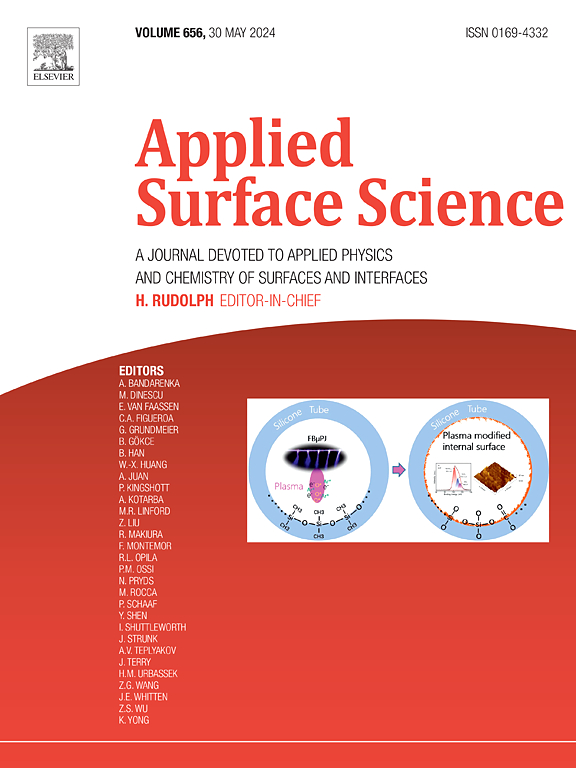Carbon quantum dots implanted sulfonated 2D-MoS2 for hydrogen evolution
IF 6.3
2区 材料科学
Q2 CHEMISTRY, PHYSICAL
引用次数: 0
Abstract
We report the enhancement of electrocatalytic activity in sulfonate (−SO3H) group functionalized two-dimensional molybdenum disulfide (2D-s-MoS2) nanosheets for their use in hydrogen evolution reaction (HER). These as-developed nanosheets have been decorated with sustainable biomass-derived carbon quantum dots (CQDs) via a sonochemical method, creating a s-MoS2-CQD composite material. This innovative composite demonstrates significantly improved electrocatalytic performance for the hydrogen evolution reaction (HER) via water splitting. In particular, incorporating CQDs on 2D-s-MoS2 overcomes many limitations, as observed in pristine 2D-MoS2 and 2D-s-MoS2, especially regarding low electrical conductivity and restricted electrocatalytic activity on the basal plane. Incorporating CQDs enhances electron transfer efficiency, increases the availability of active sites, and enhances overall conductivity. As a result, the s-MoS2-CQD achieves remarkable HER performance, featuring a lower overpotential of ∼ 273 mV and a reduced Tafel slope of 67 mV/dec compared to s-MoS2. These enhancements signify faster reaction kinetics, accelerated H* adsorption–desorption, and greater catalytic efficiency. Furthermore, using sustainably synthesized CQDs positions this approach as a cost-effective, scalable, and environmentally friendly alternative to traditional noble-metal catalysts. This research highlights the potential of functionalized two-dimensional materials, such as s-MoS2, implanted with zero-dimensional materials, such as CQDs, to advance sustainable hydrogen production technologies, thereby contributing to the global shift towards clean energy solutions.


碳量子点植入磺化2D-MoS2用于析氢
我们报道了磺酸盐(−SO3H)基团功能化的二维二硫化钼(2D-s-MoS2)纳米片的电催化活性增强,用于析氢反应(HER)。这些开发的纳米片通过声化学方法用可持续生物质衍生的碳量子点(CQDs)装饰,创造了s-MoS2-CQD复合材料。这种创新的复合材料通过水裂解显着提高了析氢反应(HER)的电催化性能。特别是,在2D-s-MoS2上结合CQDs克服了许多限制,如在原始2D-MoS2和2D-s-MoS2中观察到的,特别是在低电导率和基面上有限的电催化活性方面。加入CQDs可以提高电子传递效率,增加活性位点的可用性,并提高整体导电性。因此,与s-MoS2相比,s-MoS2- cqd具有较低的过电位(~ 273 mV)和67 mV/dec的塔菲尔斜率(Tafel slope),实现了卓越的HER性能。这些增强意味着更快的反应动力学,加速H*吸附-解吸,和更高的催化效率。此外,使用可持续合成的cqd使这种方法成为传统贵金属催化剂的一种经济、可扩展和环保的替代品。这项研究强调了功能化二维材料(如s-MoS2)植入零维材料(如CQDs)的潜力,以推进可持续制氢技术,从而促进全球向清洁能源解决方案的转变。
本文章由计算机程序翻译,如有差异,请以英文原文为准。
求助全文
约1分钟内获得全文
求助全文
来源期刊

Applied Surface Science
工程技术-材料科学:膜
CiteScore
12.50
自引率
7.50%
发文量
3393
审稿时长
67 days
期刊介绍:
Applied Surface Science covers topics contributing to a better understanding of surfaces, interfaces, nanostructures and their applications. The journal is concerned with scientific research on the atomic and molecular level of material properties determined with specific surface analytical techniques and/or computational methods, as well as the processing of such structures.
 求助内容:
求助内容: 应助结果提醒方式:
应助结果提醒方式:


